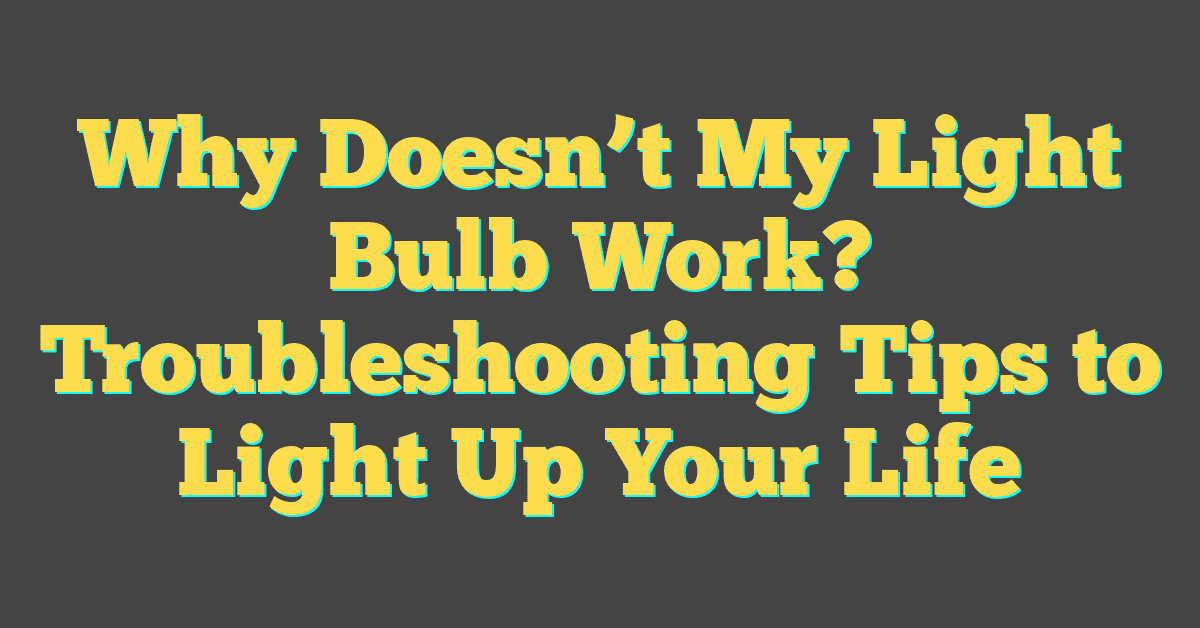Ever wondered why LED light bulbs have taken the spotlight in the world of lighting? It’s not just because they’re energy-efficient; they’re also known for their longevity. But before you make the switch, you’re probably asking yourself, “How much do LED light bulbs cost?”

Navigating the cost of LED light bulbs can feel like a maze with a range of prices and options. You’ve got your standard bulbs, smart bulbs, and those with varying lumens and color temperatures. Let’s shed some light on what you can expect to spend when you decide to brighten up your space with LEDs.
What are LED light bulbs?
Imagine you’re strolling down the lighting aisle of your favorite hardware store, looking for the perfect bulb to brighten up your home DIY project. You’ve probably noticed the dominance of LED light bulbs on the shelves. LED stands for Light Emitting Diode, which is a mouthful, but knowing this gives you a peek into the tech-savviness lighting up your living space.
These bulbs are not your grandparent’s incandescent relics. LEDs employ a semiconductor to convert electricity directly into light. This is cutting-edge technology that allows for a plethora of shapes, sizes, and colors. They work wonders in directing light exactly where you need it – ideal for your reading nook or showcasing your latest wall art.
You might be asking, What makes LEDs so special compared to their incandescent or fluorescent counterparts? For starters, LEDs are the Olympians of energy efficiency. They use up to 75% less energy and last 25 times longer than incandescent lighting. Think of it as the difference between a marathon runner and a sprinter; LEDs are built for the long haul.
There’s also the aspect of customization. LEDs come with impressive features like adjustable color temperatures, meaning you can switch from a warm, cozy glow to a bright, daylight feel with a click of a switch. This isn’t just good for ambience; it’s also perfect for tailoring light to the task at hand – be it precise color matching for your painting projects or crisp clear light for detail work on your latest build.
While some might be dazzled by LEDs’ energy savings and longevity, for a lighting enthusiast like you, the real excitement lies in the innovative applications they offer. With smart bulbs, you can control the lighting from your phone, or have it react to the sound of your voice. They’ve truly changed the game, making it possible to personalize lighting in ways that were once the stuff of science fiction.
When you’re weighing the cost of LED light bulbs against these benefits, remember that it’s not only about the price tag on the shelf. It’s about considering the long-term savings in energy bills and replacement costs, alongside the incredible versatility they bring to your home projects and everyday life.
Benefits of using LED light bulbs

You’re probably no stranger to the frustrations of flickering bulbs and the incessant need to replace them. That’s where LED light bulbs shine. Their benefits go far beyond simple illumination. Imagine customizing the ambiance of your room at a moment’s notice or slashing your energy bill without sacrificing light quality.
LED bulbs consume significantly less power than traditional incandescent lights. They use up to 75% less energy and can last 25 times longer, according to the U.S. Department of Energy. That’s not just savings in your wallet; it’s also a big win for the environment.
- Energy efficiency leads to cost savings
- Longer lifespan means fewer replacements needed
- Less environmental impact through reduced energy consumption
Consider the versatility of LEDs. With dimmable features and a wide range of color temperatures, you can create the perfect mood for any setting. They’re especially handy for your home DIY projects where precision and the right light are key. Adjusting the brightness to suit your task can now be done with ease, eliminating the strain on your eyes and making the whole process more enjoyable.
Don’t forget the innovation factor — LED bulbs are at the forefront of smart home technology. You can integrate them into your home automation system for convenience and advanced control. Imagine tweaking your lighting from your smartphone or setting the mood with voice commands as you proceed with your latest project. It’s not just futuristic; it’s functionality at your fingertips.
The initial cost of LED light bulbs might be higher than traditional bulbs, but when you factor in the long-term savings and performance benefits, it becomes clear that they’re a sound investment. Start with replacing the bulbs you use most frequently, and you’ll notice the difference in your energy usage and the quality of light throughout your home.
| Comparison Aspect | LED Bulbs | Traditional Incandescent Bulbs |
|---|---|---|
| Energy Consumption | 75% Less | – |
| Lifespan | Up to 25 Times Longer | – |
| Smart Home Integration | Yes | No |
Whether you’re lighting up your workspace or creating a cozy nook in your living room, LED bulbs offer a superior lighting experience tailored to your needs. They’re a smart choice for your home, projects, and the planet. And truth be told, once you switch to LED, you’ll never look back.
Factors that affect the cost of LED light bulbs
« Is Light Bulbs Yellow? Discover the Best Hue for Your Room
How to Keep Light Bulbs from Burning Out: 5 Pro Tips for Longer Life »

When you’re on the hunt for LED light bulbs, you’ll notice that prices aren’t uniform across the board. A myriad of factors play into the final cost of LED bulbs. Understanding these can help you find the perfect balance between upfront costs and long-term savings.
Brand Reputation and Quality
First off, brand names matter. Well-known manufacturers typically charge more for their LEDs, and that’s not just for the name. They often promise higher quality, longevity, and warranties that can make that extra investment worthwhile.
Luminosity and Energy Efficiency
The brightness and energy efficiency of LED bulbs also affect their price. Those marvelously bright and energy-sipping models? They’ll cost you a bit more. But remember, they’re designed to save you money on your electricity bill each month, tipping the scales in favor of higher efficiency.
- Wattage equivalent: LEDs consuming less power for the same light output cost more.
- Lumens: Higher lumens indicate brighter light and usually a higher price.
Advanced Features
LEDs have come a long way, with features that can dazzle even a seasoned DIYer like yourself. Those with smart technology integration are pricier because of the added convenience of app or voice control connectivity. If you’re all about creating a specific mood, dimmable LEDs or those with color-changing abilities will also add a few dollars to your bill.
| Feature | Typical Premium |
|---|---|
| Smart technology | 20-30% |
| Dimmable function | 5-15% |
| Color-changing | 25-35% |
Certifications and Safety
Safety is non-negotiable. LEDs that boast certifications like ENERGY STAR or UL listings might be more expensive due to the rigorous testing they undergo. These certifications ensure that you’re bringing a product into your home that’s not only efficient but also meets high safety standards.
In short, while the sticker price of an LED bulb may grab your attention, peek beneath the surface. Consider what you’re really getting for your money: a brighter, smarter, and potentially more colorful lighting experience that’s kinder to both your wallet and the planet over time.
Different types of LED light bulbs available

When you’re in the market for LED bulbs, you’ll find an impressive range of options. Each type brings its own set of features tailor-made for various lighting needs.
Standard A19 LED Bulbs
These are your go-to classic bulbs, perfect for general lighting in lamps and fixtures. They’re the LED equivalent of traditional incandescent bulbs and are fantastic for everyday use in your home.
Globe LED Bulbs
Globe bulbs, often found in bathroom vanities and pendant lights, offer a soft, widespread light. Their larger surface area disperses light evenly, giving your space a warm, welcoming ambience.
Candle LED Bulbs
These boast a decorative flare, resembling the shape of a flame. Ideal for chandeliers or sconces, candle LEDs are not only stylish but are often dimmable – a great way to set the mood.
- Reflector LED Bulbs: Adorn your spotlights with these precise lighting solutions. Whether highlighting artwork or illuminating a workspace, reflector LEDs focus light for sharp, directed beams.
- Tube LED Bulbs: They’re the modern take on fluorescent tubes. Typically found in garages or basements, tube LEDs provide a bright, consistent light over a larger area, brilliant for task-heavy spaces.
- Smart LED Bulbs: For those who love technology, these bulbs sync with your smart home system. Adjust the brightness, color, and even turn lights on or off remotely – all from your device.
Lastly, Color and Tunable White LED Bulbs are ideal if you’re into DIY home projects. They let you play with color schemes or adjust the color temperature to match the time of day or desired mood, adding a creative touch to your space. Whether it’s for task lighting, accent lighting, or simply to add a splash of color, you’re bound to find an LED bulb that suits your needs.
Understanding the price range of LED light bulbs

When you’re eyeing LED light bulbs for your next home project, it’s vital to note that prices can vary widely based on several factors. You’ll find that standard A19 LED bulbs are your entry-level option typically ranging from $2 to $8 per bulb, making them a cost-effective choice for general lighting needs.
As you explore more specialized LEDs like globe, candle, and reflector bulbs, expect to invest a bit more—usually anywhere from $5 to $15 for each bulb. These are excellent for adding a decorative touch while still serving practical purposes such as spotlights and task lighting.
Smart LED Bulbs: The Game Changer
Now if you’re a tech enthusiast who loves to add a bit of high-tech flavor to your lighting, smart LED bulbs are the way to go. These bulbs offer not just illumination but also the flexibility of controlling them via your smartphone or voice commands. You’re looking at a price range of $10 to $50 or more per bulb, but with the added convenience of adjusting brightness, color, and even set schedules.
Color and Tunable White LED Bulbs: Aesthetic and Ambiance Control
For those who really appreciate the ability to customize room ambiances, color and tunable white LED bulbs are the perfect picks. With the ability to shift through millions of colors and various temperatures of white light, these bulbs create the perfect mood for any occasion. Prices here can range from $15 to $35 per bulb.
Here’s a quick price rundown for an easy reference:
| Type of LED Bulb | Price Range |
|---|---|
| Standard A19 LED bulbs | $2 – $8 |
| Globe, Candle, Reflector | $5 – $15 |
| Smart LED bulbs | $10 – $50+ |
| Color & Tunable White | $15 – $35 |
Bear in mind that while upfront costs of LED bulbs tend to be higher compared to traditional bulbs, their long-term savings on energy consumption and longer life span make them a financially savvy choice in the long run. Additionally, prices may fluctuate based on brand quality, features, and where you shop. Always keep an eye out for discounts or bulk deals if you’re planning a larger home renovation project.
Conclusion
So you’ve seen the array of LED light bulbs out there and the varying prices that come with them. Whether you go for the standard options or dive into the world of smart bulbs, remember that your initial investment pays off in the long run. LED bulbs aren’t just about lighting up a room—they’re about tailoring your space to your needs and saving on energy bills down the line. Now that you’re equipped with this knowledge, you’re ready to make an informed choice that brightens your home and your future.
Frequently Asked Questions
What types of LED light bulbs are mentioned in the article?
The article highlights numerous LED bulb types which include standard A19 LEDs, globe, candle, reflector bulbs, smart LED bulbs, and color and tunable white LED bulbs.
Are LED light bulbs cost-effective in the long run?
Yes, LED light bulbs are designed for long-term cost-effectiveness due to their low energy consumption and long lifespan compared to traditional bulbs.
Can LED light bulbs be customized?
LED light bulbs offer a high degree of customization, including options like adjustable color and brightness, often controllable through smart home systems.
What is an A19 LED bulb?
An A19 LED bulb is a standard, medium base bulb commonly used for everyday household lighting, known for its versatility and energy efficiency.
Do LED bulbs vary in price?
Yes, the price of LED light bulbs can vary widely, from cost-effective standard A19 bulbs to more expensive, specialized options like smart LEDs or tunable white bulbs.




